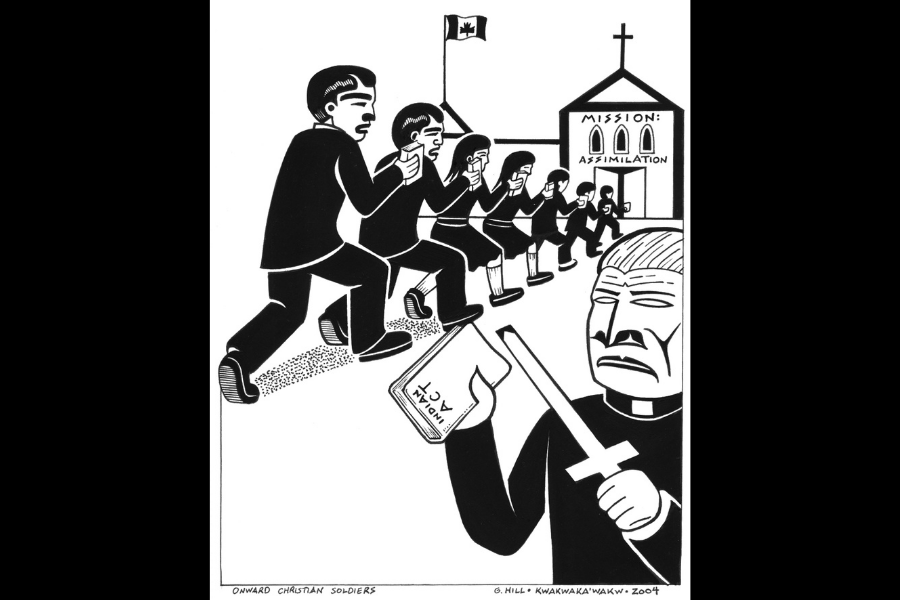
"Onward Christian Soldiers" by Kwakwaka’wakw artist Gord Hill.
Graphic novel aims to educate K-12 learners on residential school history
Despite growing up in North Vancouver down the road from the former St. Paul’s (Squamish) Indian Residential (1899-1958), Sean Carleton says he learned little about Indigenous Peoples, settler colonialism and the complicated history of residential schooling in his youth.
A new assistant professor in the departments of Native studies and history, Carleton credits a combination of his university education and a Kwakwaka’wakw family member and Survivor on his partner’s side that revealed the ongoing effects of the residential school system. As a settler scholar of Irish and English descent, Carleton remains committed to raising greater awareness about the residential school system “to ensure that other settlers cannot use their ignorance of the past to justify their ongoing complicity in settler colonialism.”
Shortly after the fifth anniversary of the Truth and Reconciliation Commission’s (TRC) final report, former TRC chair Senator Murray Sinclair stated that “this history is not going to stay in the past.” This inspired Carleton to action, which led him and his project collaborators to apply for the Indigenous Initiatives Fund at the University of Manitoba.
The project, which is a collaboration between the department of Native studies, the National Centre for Truth and Reconciliation (NCTR) and the University of Manitoba Press, will create an accessible learning tool in the medium of a graphic novel called A Knock on the Door. The novel will be illustrated by Kwakwaka’wakw artist Gord Hill.
In the spirit of putting ‘truth’ before ‘reconciliation,’ Carleton says the goal of the project is “to establish innovative linkages on campus to support knowledge mobilization and education throughout Manitoba and Canada.”
“Comics, or graphic novels, are an accessible medium to share information and education,” he says. “They are a transformative tool for empathic and empowering teaching and learning.”
There are plenty of resources that currently exist in educating adults, including the TRC’s publication entitled A Knock on the Door: The Essential History of Residential Schools from the Truth and Reconciliation Commission (University of Manitoba Press, 2016), and Carleton hopes to use the publication as the launching point for the graphic novel.
“Many Indigenous comics creators are showing the power of the graphic form as a way of storytelling and consciousness raising, including one of my colleagues and grant collaborator Niigaan Sinclair,” Carleton says. As well, he adds that UM is in a unique position “to be a hub of residential school knowledge,” citing the advantages of having the NCTR on campus, as well as a strong Native studies department. “Collaboration and knowledge dissemination are the main goals for this project.”
Inspired by the TRC’s call to action #62, which calls for “age-appropriate curriculum on residential schools,” both publication and dissemination of A Knock on the Door is to work alongside educators in the K-12 system to develop a meaningful way for young learners to become aware of residential school history.
Awarded $30,000 for the project, A Knock on the Door is one of eight projects selected this year for a total of $350,514 in funding. The Indigenous Initiative Funds are open to faculties, schools, colleges, libraries and administrative units to support unit-based projects that further the Indigenous Achievement goals and priorities outlined in Taking Our Place, UM’s Strategic Plan.






